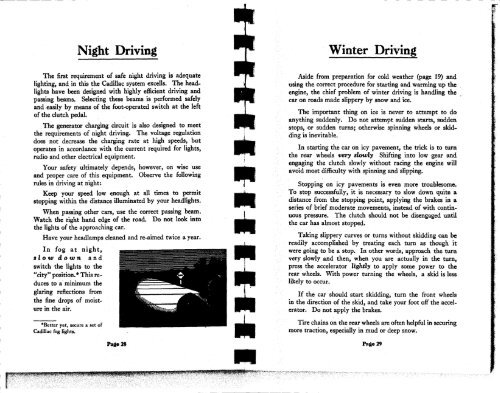1938 Cadillac V16 - GM Heritage Center
1938 Cadillac V16 - GM Heritage Center
1938 Cadillac V16 - GM Heritage Center
Create successful ePaper yourself
Turn your PDF publications into a flip-book with our unique Google optimized e-Paper software.
Night Driving<br />
Winter Driving<br />
The first requirement of safe night driving is adequate<br />
lighting, and in this the <strong>Cadillac</strong> system excells. The headlights<br />
have been designed with highly efficient driving and<br />
passing beams. Selecting these beams is performed safely<br />
and easily by means of the foot-operated switch at the left<br />
of the clutch pedal.<br />
The generator charging circuit is also designed to meet<br />
the requirements of night driving. The voltage regulation<br />
does not decrease the charging rate at high speeds, but<br />
operates in accordance with the current required for lights,<br />
radio and other electrical equipment.<br />
Your safety ultimately depends, however, on wise use<br />
and proper care of this equipment. Observe the following<br />
rules in driving at night:<br />
Keep your speed low enough at all times to permit<br />
stopping within the distance illuminated by your headlights.<br />
When passing other cars, use the correct passing beam.<br />
Watch the right hand edge of the road. Do not look into<br />
the lights of the approaching car.<br />
Have your headlamps cleaned and re-aimed twice a year.<br />
In fog at night,<br />
slowdown and<br />
switch the lights to the<br />
"city" position.* This reduces<br />
to a minimum the<br />
glaring reflections from<br />
the fine drops of moisture<br />
in the air.<br />
*Better yet, secure a set of<br />
<strong>Cadillac</strong> fog lights.<br />
Page 28<br />
Aside from preparation for cold weather (page 19) and<br />
using the correct procedure for starting and warming up the<br />
engine, the chief problem of winter driving is handling the<br />
car on roads made slippery by snow and ice.<br />
The important thing on ice is never to attempt to do<br />
anything suddenly. Do not attempt sudden starts, sudden<br />
stops, or sudden turns; otherwise spinning wheels or skidding<br />
is inevitable.<br />
In starting the car on icy pavement, the trick is to turn<br />
the rear wheels very slowly Shifting into low gear and<br />
engaging the clutch slowly without racing the engine will<br />
avoid most difficulty with spinning and slipping.<br />
Stopping on icy pavements is even more troublesome.<br />
To stop successfully, it is necessary to slow down quite a<br />
distance from the stopping point, applying the brakes in a<br />
series of brief moderate movements, instead of with continuous<br />
pressure. The clutch should not be disengaged until<br />
the car has almost stopped.<br />
Taking slippery curves or turns without skidding can be<br />
readily accomplished by treating each turn as though it<br />
were going to be a stop. In other words, approach the turn<br />
very slowly and then, when you are actually in the turn,<br />
press the accelerator lightly to apply some power to the<br />
rear wheels. With power turning the wheels, a skid is less<br />
likely to occur.<br />
If the car should start skidding, turn the front wheels<br />
in the direction of the skid, and take your foot off the accelerator.<br />
Do not apply the brakes.<br />
Tire chains on the rear wheels are often helpful in securing<br />
more traction, especially in mud or deep snow.<br />
Page 29
















